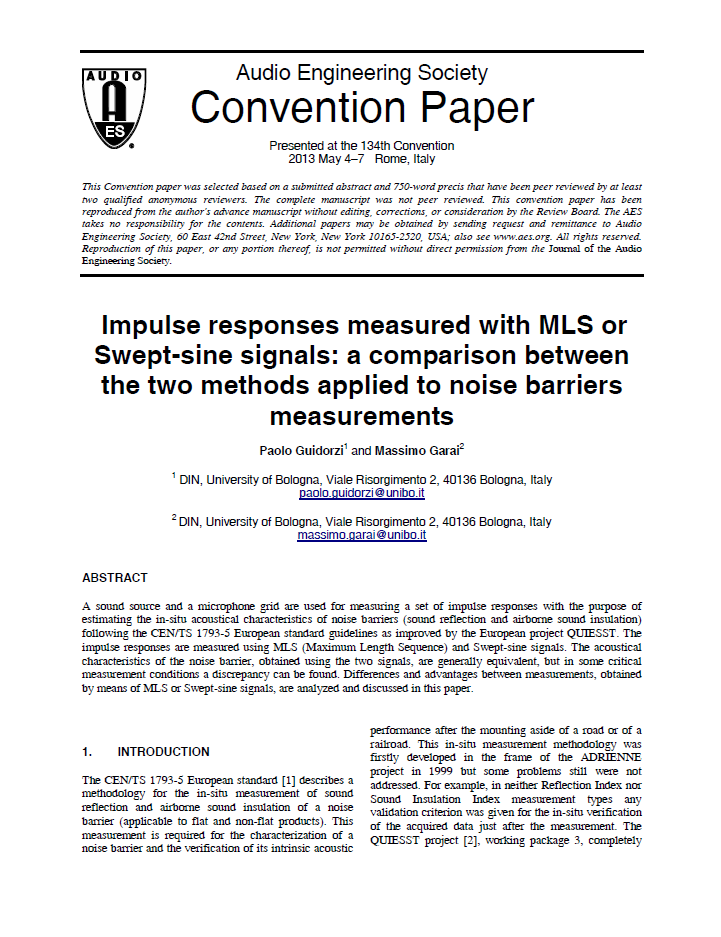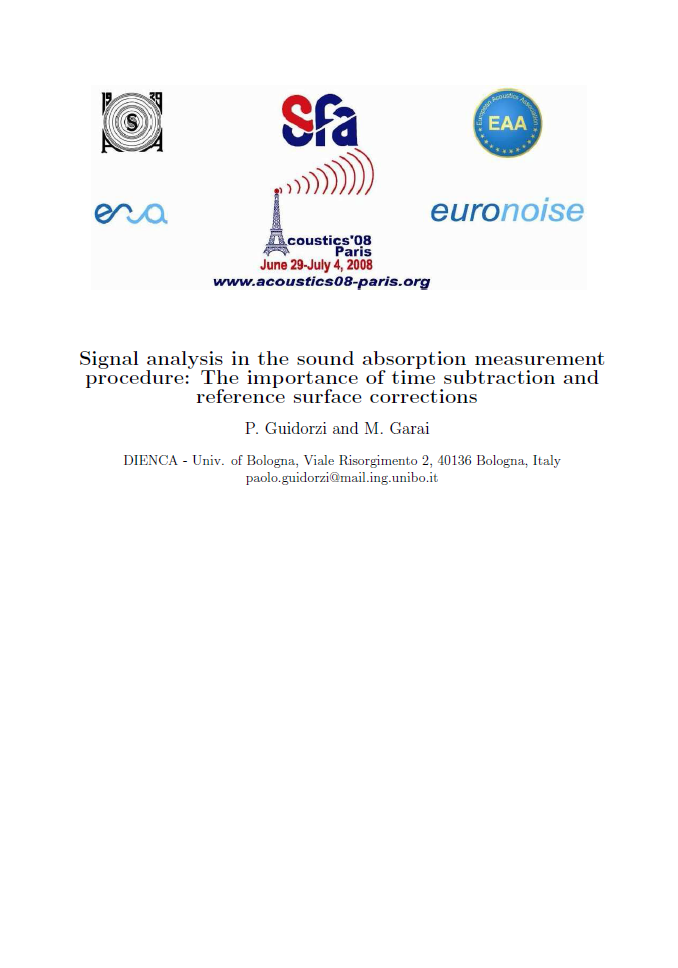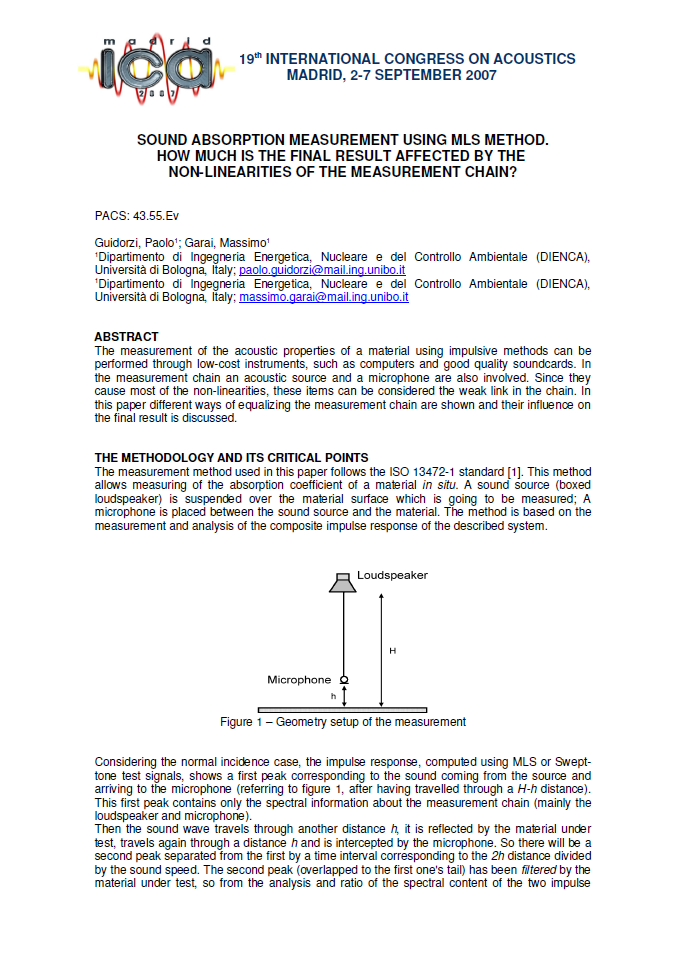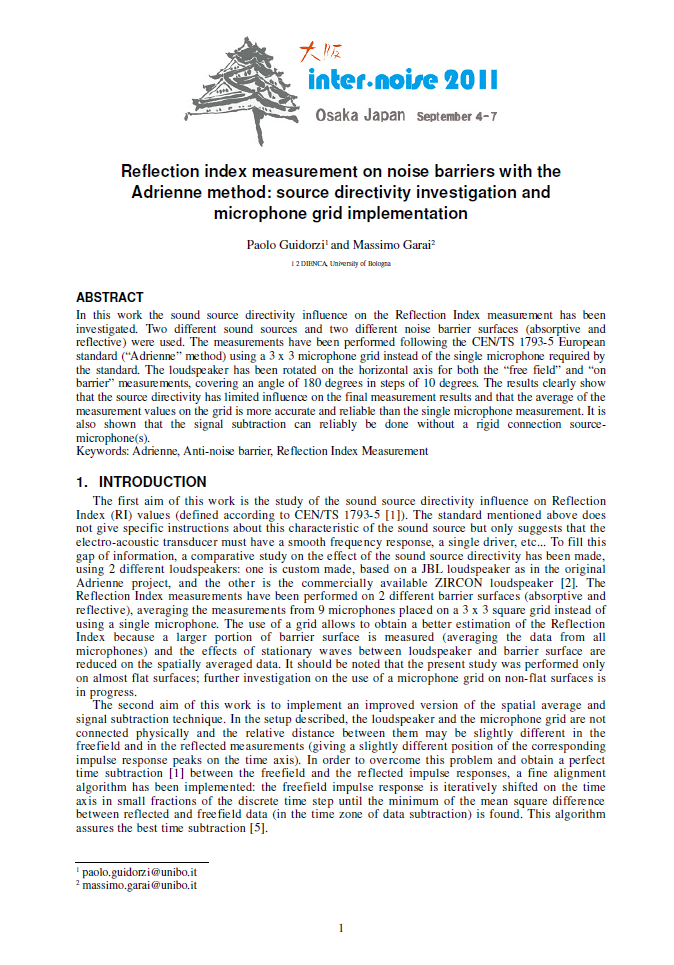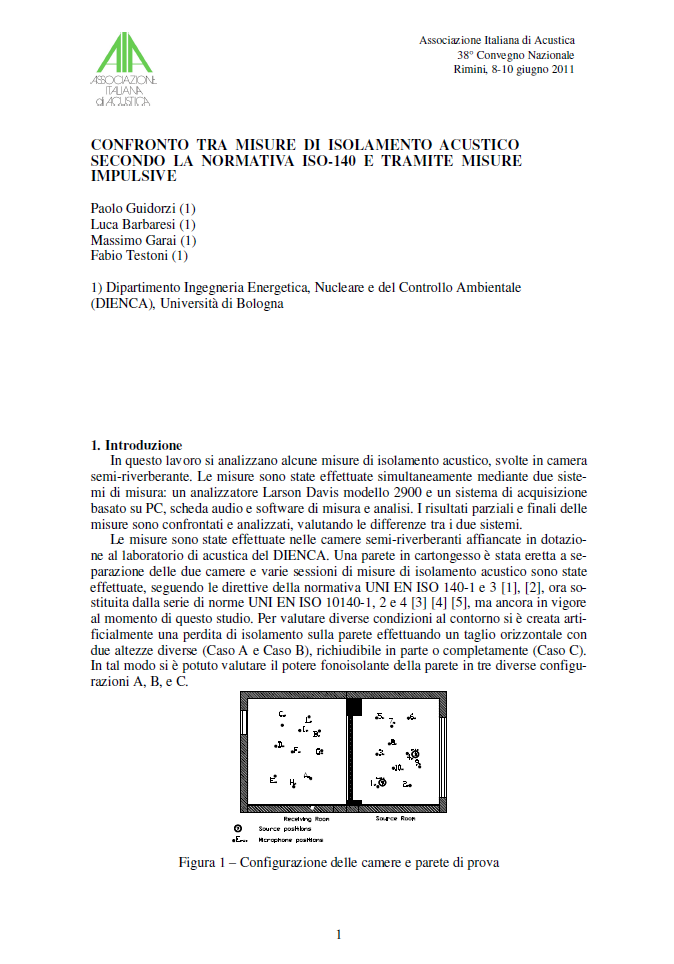| |
Selected Papers
Signal Processing applied to Acoustics
| P. Guidorzi, M. Garai, “Impulse responses measured with MLS or Swept-sine signals: a comparison between the two methods applied to noise barriers measurements”, Proc. AES Convention, Roma, Italy, ISBN 978-0-937803-91-2, Paper ID 8914, 1-10 (2013) ABSTRACT A sound source and a microphone grid are used for measuring a set of impulse responses with the purpose of estimating the in-situ acoustical characteristics of noise barriers (sound reflection and airborne sound insulation) following the CEN/TS 1793-5 European standard guidelines as improved by the European project QUIESST. The impulse responses are measured using MLS (Maximum Length Sequence) and Swept-sine signals. The acoustical characteristics of the noise barrier, obtained using the two signals, are generally equivalent, but in some critical measurement conditions a discrepancy can be found. Differences and advantages between measurements, obtained by means of MLS or Swept-sine signals, are analyzed and discussed in this paper. |
|
| P.Guidorzi, M.Garai, "Signal analysis in the sound absorption measurement procedure: the importance of time subtraction and reference surface corrections", Proc. Acoustics ‘08, Paris, France, ISBN 978-2-9521105-4-9, 1755-1760 (2008) ABSTRACT The in situ measurement of the sound absorption coefficient (following the ISO 13472-1 standard) of highly absorbing materials, which are typically employed in room acoustics correction, presents some inherent difficulties. These materials present high sound absorption coefficient indeed, but usually low sound insulation index and are installed over highly reflective surfaces. This leads to some measurement problems, partially solved by means of the reference surface method. In this work some measurement examples on the same materials but with different boundary conditions are analyzed and the improvements on the results, due to reference surface normalization and time domain subtraction of free field response, are discussed. |
|
| P.Guidorzi, M.Garai, “Sound absorption measurement using MLS method. How much is the final result affected by the non-linearities of the measurement chain?”, Proc. 19th I.C.A 2007, Madrid, Spain, ISBN 84-87985-12-2, Special issue of Revista de Acústica, 38(3-4), Paper RBA-11-009 (2007) ABSTRACT The measurement of the acoustic properties of a material using impulsive methods can be performed through low-cost instruments, such as computers and good quality soundcards. In the measurement chain an acoustic source and a microphone are also involved. Since they cause most of the non-linearities, these items can be considered the weak link in the chain. In this paper different ways of equalizing the measurement chain are shown and their influence on the final result is discussed. |
|
| M. Garai, P. Guidorzi, “Reflection index measurement on noise barriers with the Adrienne method: source directivity investigation and microphone grid implementation” (invited paper), Proc. Inter-Noise 2011, Osaka, Japan, Paper 427100, 1-6 (2011) ABSTRACT In this work the sound source directivity influence on the Reflection Index measurement has been investigated. Two different sound sources and two different noise barrier surfaces (absorptive and reflective) were used. The measurements have been performed following the CEN/TS 1793-5 European standard (“Adrienne” method) using a 3 x 3 microphone grid instead of the single microphone required by the standard. The loudspeaker has been rotated on the horizontal axis for both the free field and on barrier measurements, covering an angle of 180 degrees in steps of 10 degrees. The results clearly show that the source directivity has limited influence on the final measurement results and that the average of the measurement values on the grid is more accurate and reliable than the single microphone measurement. It is also shown that the signal subtraction can reliably be done without a rigid connection source-microphone(s). |
|
| P. Guidorzi , L. Barbaresi, M. Garai, F. Testoni, "Confronto tra misure di isolamento acustico secondo la normativa ISO-140 e tramite misure impulsive" Atti XXXVIII Conv. A.I.A., Rimini, Italy, ISBN 978-88-88942-34-6, Paper S4-A6, 1-8 (2011) ABSTRACT In questo lavoro si analizzano alcune misure di isolamento acustico, svolte in camera semi-riverberante. Le misure sono state effettuate simultaneamente mediante due sistemi di misura: un analizzatore Larson Davis modello 2900 e un sistema di acquisizione basato su PC, scheda audio e software di misura e analisi. I risultati parziali e finali delle misure sono confrontati e analizzati, valutando le differenze tra i due sistemi. Le misure sono state effettuate nelle camere semi-riverberanti affiancate in dotazione al laboratorio di acustica del DIENCA. Una parete in cartongesso è stata eretta a separazione delle due camere e varie sessioni di misure di isolamento acustico sono state effettuate, seguendo le direttive della normativa UNI EN ISO 140-1 e 3, ora sostituita dalla serie di norme UNI EN ISO 10140-1, 2 e 4, ma ancora in vigore al momento di questo studio. Per valutare diverse condizioni al contorno si è creata artificialmente una perdita di isolamento sulla parete effettuando un taglio orizzontale con due altezze diverse (Caso A e Caso B), richiudibile in parte o completamente (Caso C). In tal modo si è potuto valutare il potere fonoisolante della parete in tre diverse configurazioni A, B, e C. |
|

Questo sito non utilizza cookies. Componenti di terze parti potrebbero utilizzarli. Per maggiori informazioni clicca qui
Selected papers
Signal processing
